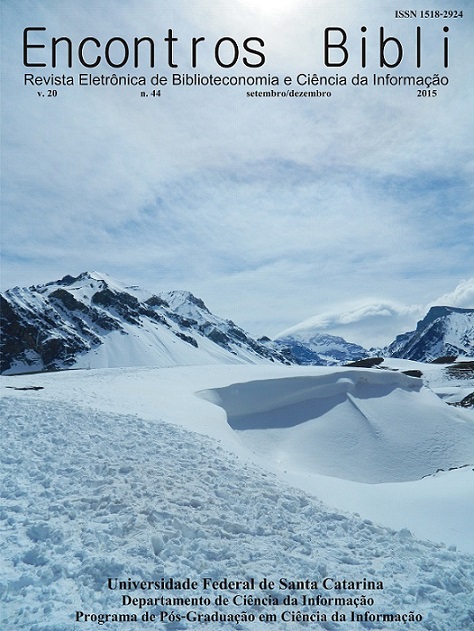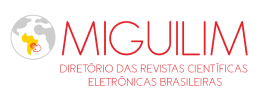Characteristics of the teachers research activities of the Institutos Federais de Educação, Ciência e Tecnologia
DOI:
https://doi.org/10.5007/1518-2924.2015v20n44p73Keywords:
Institutos Federais de Educação, Ciência e Tecnologia, Research activities: characterisitcs, Research activities: stimuli, Communication of research results, Support for research development, Nucleus for technology development in Brazilian universitiesAbstract
Intends identify the origins of stimuli to research as felt by the faculty of the Institutos Federais de Educação, Ciência e Tecnologia, in Brazil, and their opinion about the support offered by research, as well as formats and channels that they use to communicate their production. Universe is composed of 24335 professors working in the 38 Institutos Federais currently existing in the country from which a simple random sample was extracted of 165 individuals, divided proportionally to the number of professors in each Institute. A survey in the curricula vitae of the 165 professors in the sample, registered in the Plataforma Lattes Conselho Nacional de Desenvolvimento Científico e Tecnológico (CNPq), resulted in the identification of 96 up-dated curricula with registered production. A questionnaire with open and closed questions emailed to these 96 professors supplied the data, then analyzed through quantitative and qualitative techniques. Results showed that professors at the Institutos Federais recognize as the main stimulus to do research the requisites to promotion and academic career. As for support from entities in the campus, they find the nucleus for technology innovation and the special departments for research not effective. The main channel for communicate research results are oral presentation followed by papers published in congresses and other such events. Bibliographic production is recognized as the preferred channel.
Downloads
References
ARBOIT, Aline Elis; BUFREM, Leilah Santiago. Produção de trabalhos científicos em eventos nacionais da área de ciência da informação. Transinformação, v. 23, n. 3, p. 207-217, 2011. Disponível em:
< http://periodicos.puc-campinas.edu.br/seer/index.php/transinfo/article/view/465/445>. Acesso em: 30 set. 2015.
BORGES, Mario Neto. As fundações estaduais de amparo à pesquisa e o desenvolvimento da ciência, tecnologia e inovação no Brasil. Revista USP, São Paulo, n. 89, p. 174-189, mar./maio 2011. Disponível em: <http://www.revistas.usp.br/revusp/article/view/13876>. Acesso em: 9 abr. 2014.
BRANCO, Gilberto et al. Propriedade intelectual. Curitiba: Aymará, 2011.
BRASIL. Lei n. 10.973, de 2 de dezembro de 2004. Dispõe sobre incentivos à inovação e à pesquisa científica e tecnológica no ambiente produtivo e dá outras providências. Diário Oficial da União, Brasília, DF, 3 de dezembro de 2004. Disponível em: <http://www.planalto.gov.br/ccivil_03/_ato2004-2006/2004/lei/l10.973.htm>. Acesso em: 30 set. 2015.
BRASIL. Lei n. 11.892, de 29 de dezembro de 2008. Institui a Rede Federal de Educação Profissional, Científica e Tecnológica. Cria os Institutos Federais de Educação, Ciência e Tecnologia, e dá outras providências. Diário Oficial da União, Brasília, DF, 29 de dezembro de 2008. Disponível em:
<http://www.planalto.gov.br/ccivil_03/_ato2007-2010/2008/lei/l11892.htm>. Acesso em: 30 set. 2015.
BUENO, Wilson Costa. Comunicação científica e divulgação científica: aproximações e rupturas conceituais. Inf. Inf., Londrina, v. 15, n. esp, p. 1-12, 2010. Disponível em: <http://www.uel.br/revistas/uel/index.php/informacao/article/view/6585>. Acesso em: Acesso em: 30 set. 2015.
FERREIRA, Lucas Pazoline da Silva. Ciência e rizoma: uma reflexão sobre produção e comunicação científico-acadêmica. DataGramaZero - Revista de Informação, v.16, n.4, 2015. Disponível em: <http://www.dgz.org.br/ago15/Art_03.htm>. Disponível em: 30 set. 2015.
FREIRE-MAIA, Newton. A ciência por dentro. 5. ed. Petrópolis: Vozes, 1998.
HARDRÉ, Patricia L. et al. Faculty motivation to do research: across disciplines in research-extensive universities. Journal of the Professoriate, v. 5, n. 1, p. 35-69, 2011.
HURD, Julie M. Scientific communication: new roles and new players. Science & Technology Libraries, v. 25, n. 1-2, p. 5-22, 2004. Disponível em: <http://www.hawworthpress.com/web/stl>. Acesso em: 6 nov. 2014.
MEADOWS, Arthur Jack. A comunicação científica. Brasília: Briquet Lemos, 1999.
MUGNAINI; Rogério; DIGIAMPIETRI, Luciano Antonio; MENA-CHALCO, Jesús Pascual.
Comunicação científica no Brasil (1998-2012): indexação, crescimento, fluxo e dispersão
TransInformação, Campinas, n. 26, v 3, p.239-252, set./dez., 2014. Disponível:
<http://periodicos.puc-campinas.edu.br/seer/index.php/transinfo/article/view/2629>. Acesso em: 30 set. 2015.
QUERIDO, André Luiz de Souza. Destino das patentes das universidades brasileiras e mapeamento das atividades dos núcleos de inovação tecnológica. Rio de Janeiro, 2011. 147 f. Tese (Doutorado em Biotecnologia Vegetal) – Centro de Ciências da Saúde – Universidade Federal do Rio de Janeiro, Rio de Janeiro, 2011. Disponível em: <http://fenix3.ufrj.br/50/teses/d/CCS_D_AndreLuizDeSouzaQuerido.pdf>. Acesso em: 12 nov. 2013.
SCHWARTZMAN, Simon. Modos de produção do conhecimento científico e tecnológico e as oportunidades para o setor de ensino superior particular. In: ENCONTRO NACIONAL DE PÓS-GRADUAÇÃO NAS IES PARTICULARES, 6., 2005, Salvador. Anais... Salvador, 2005. Disponível em:<http://www.schwartzman.org.br/simon/2005_salvador.pdf>. Acesso em: 16 ago. 2013.
SILVA, Márcia Regina; SILVA, Jeane dos Santos; SANTOS-ROCHA, Edneia Silva.
O profissional da informação como produtor de conhecimentos: análise bibliométrica da produção científica de bibliotecários.
Liinc em Revista, Rio de Janeiro, v. 9, n. 1, p. 103-123, 2013. Disponível em: <http://revista.ibict.br/liinc/index.php/liinc/article/view/530/403>. Acesso em: 30 set. 2015.
WEITZEL, Simone da Rocha. Fluxo da informação científica. In: POBLACION, Dinah Aguiar; WITTER, Geraldina Porto; SILVA, José Fernando Modesto da (Org.) Comunicação e produção científica: contexto e avaliação. São Paulo: Angellara, 2006. Cap. 3, p. 81-114.
Downloads
Published
How to Cite
Issue
Section
License
Copyright (c) 2015 Valmira Perucchi, Suzana Pinheiro Machado Mueller

This work is licensed under a Creative Commons Attribution 4.0 International License.
The author must guarantee that:
- there is full consensus among all the coauthors in approving the final version of the document and its submission for publication.
- the work is original, and when the work and/or words from other people were used, they were properly acknowledged.
Plagiarism in all of its forms constitutes an unethical publication behavior and is unacceptable. Encontros Bibli has the right to use software or any other method of plagiarism detection.
All manuscripts submitted to Encontros Bibli go through plagiarism and self-plagiarism identification. Plagiarism identified during the evaluation process will result in the filing of the submission. In case plagiarism is identified in a manuscript published in the journal, the Editor-in-Chief will conduct a preliminary investigation and, if necessary, will make a retraction.
This journal, following the recommendations of the Open Source movement, provides full open access to its content. By doing this, the authors keep all of their rights allowing Encontros Bibli to publish and make its articles available to the whole community.
Encontros Bibli content is licensed under a Creative Commons Attribution 4.0 International License.
Any user has the right to:
- Share - copy, download, print or redistribute the material in any medium or format.
- Adapt - remix, transform and build upon the material for any purpose, even commercially.
According to the following terms:
- Attribution - You must give appropriate credit, provide a link to the license, and indicate if changes were made. You may do so in any reasonable manner, but not in any way that suggests the licensor endorses you or your use.
- No additional restrictions - You may not apply legal terms or technological measures that legally restrict others from doing anything that the license permits.

























